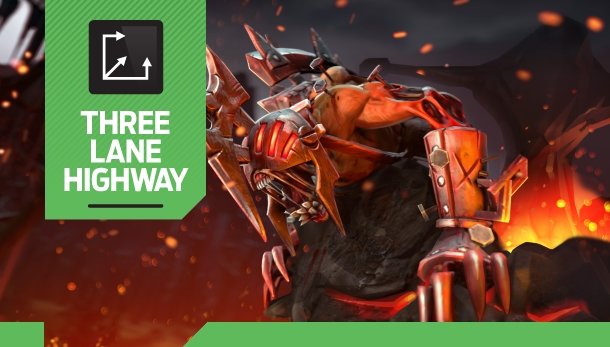Three Lane Highway: learning to watch Dota 2 as a newcomer

Three Lane Highway is Chris' sometimes serious, sometimes silly column about Dota 2.
Later this month I'll be attending ESL One Frankfurt to cover the tournament for PC Gamer. It's one of the last high profile Dota 2 competitions before The International, and the best chance most European fans are going to get to watch some of these teams play before they win eleventy million dollars at TI4, buy private islands, and vanish.
If you're considering attending then you probably play Dota 2. You know something about the meta, drafting, laning, teamfights, whatever. You're capable of replicating many of the things that you watch professional teams do—albeit imperfectly—on your own time, and doing so constitutes a big part of your hobby. You watch Dota because you play Dota.
That might seem like an obvious point to make but it is the single most glaring distinction between electronic sport and physical sport, traditional sport, meat sport, whatever you want to call it. Dota 2 spectators are also players because it's easy to be a player, even if it's difficult to play well; the distinction between a professional and the rest of us isn't quite as pronounced as it is in other forms of sport. Spectators learn to look for the innumerable infintessimally small ways in which professional players express their talent over the course of a match: the things they don't do, the space that a small action creates, the late-game impact of an early-game twist of the knife.
It's for this reason that professional Dota 2 is incredibly hard to watch if you don't play the game. The same is true for StarCraft, to an extent, but StarCraft benefits from the fact that is a contest between armies , a unit of competition that most people will understand. Dota 2 is about ghosts and fish people and bears who really hate each other's rock gardens. You can make comparisons to basketball and chess all you like, but nobody has ever included a sapient ball of beep-booping light on a basketball team and Gary Kasparov never won a match from the back of a prowling jungle panther, much to everybody's great loss.
I don't think that this necessarily needs to be the case. The difficulty of watching professional Dota, I mean, not the thing about Gary Kasparov and a panther. That's not going to happen. But it's not impossible for newcomers to get something out of watching ESL One or The International. They just need to be told where to look, and what to look for. In a game that overwhelms with detail, the easiest way to access the good stuff is to refine and simplify.
When heroes fight, look at positioning—not abilties. Teamfights are the single most difficult thing for a new spectator to parse. They're an expression of the game's churning background algorithms. Economics and skills smash into one another and create a new variable that is woven back into the match itself. Eventually, you're going to need to understand all of it—the abilities being used, the items, the heroes, the phase of the game, all of it. At first, though, look at where people are standing.
The biggest gaming news, reviews and hardware deals
Keep up to date with the most important stories and the best deals, as picked by the PC Gamer team.
Pay attention to the relative positions of opposing heroes. Who's alone or unprotected? Who is moving aggressively forward? Who is being forced to move, either by threat of danger or a particular spell? Much of Dota 2 is forcing the other guy to make a sub-optimal play, and you can detect inefficiency by figuring out which team is leading and which team is reacting. Strip away the map and the characters and the casters for a bit and see the heroes as pieces on a board. If you're familiar with other team sports or strategy games then thinking of Dota in terms of movement makes it much easier to parse. Don't worry about skillshots or stun-stacking or whatever: think about flanking movements, feints, counter-attacks and the rest will follow. If somebody is bellowing "BLACK HOOOLE!", accept that it is exciting and concentrate on the important fact: a whole bunch of characters are now squashed together where they don't want to be.
At the beginning of the game, watch how teams arrange themselves on the map—and how they change it up after a few minutes. A lot of arcane thinking goes into the laning phase. Support characters will spend this time doing unfathomable things in the jungle to prepare their teams for the midgame. Carries will wave their weapons in little statacco 'no-no-no-yes' motions before smacking creeps so that money falls out. Midlaners will periodically rush off up or down the river to gather up a magic rune (?) that is actually a glowing coloured rock (?) with magic properties including the ability to refill a bottle with water (?)
You're probably not going to understand any of this on day one, so look at the minimap instead. Treat the early game as one very large, very slow teamfight, and figure out who is moving to get the jump on the other team and who is moving to react. That'll give you a sense of who is leading the game, and their success or failure will almost certainly become the narrative of the match as a whole.
Worry about objectives, not graphs or battles. An objective is anything that a team can claim or destroy to get themselves closer to the enemy ancient. This is normally a tower, and sometimes Roshan. Even in the professional scene you'll sometimes see teams focus on winning fights to the exclusion of the objectives that actually win the game. If it's not obvious who is coming out on top of teamfights, look at who is managing to claim objectives afterwards. You can tell the difference by the way the commentators respond. Teamfights are exciting. People yell. People talk very quickly. Afterwards, though, somebody will say something slowly and clearly about towers lost or space created or Roshan attempts uncontested, and this is the main thing you should be paying attention to at this point.
Concentrate on a caster's tone, not what they're saying. Knowledge is important, and imparting it is a crucial part of a caster's job, but it's not the part that a newcomer is going to find especially useful. Or, to put a finer point on it, game knowledge is best absorbed slowly. If you try to understand everything that gets said you'll be turned off the game. Somebody will say something about someone called "Lunar Russian, Herman the Dominator" and you will have no idea that he's talking about a panther-riding moon lady opting for lifesteal over magic immunity. You don't need to. That's fine. Their tone tells you that this might be a risky thing to have happened, whatever it is: Herman the Dominator might be in trouble. That's all you need to know.
Let casters steer the mood of the game and accept that you'll figure out the details slowly. This is more or less the only way to do it. Besides: it's as easy as it gets. The amount of worthy action occurring on screen is directly proportional to the number of people who are currently screaming. Unless you are in the Korean casting booth during The International 2013 . In that case, well, disregard everything I just said.
To read more Three Lane Highway, click here .
Joining in 2011, Chris made his start with PC Gamer turning beautiful trees into magazines, first as a writer and later as deputy editor. Once PCG's reluctant MMO champion , his discovery of Dota 2 in 2012 led him to much darker, stranger places. In 2015, Chris became the editor of PC Gamer Pro, overseeing our online coverage of competitive gaming and esports. He left in 2017, and can be now found making games and recording the Crate & Crowbar podcast.


